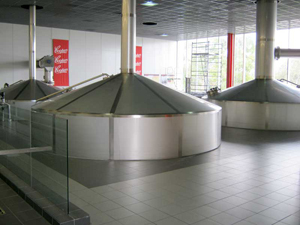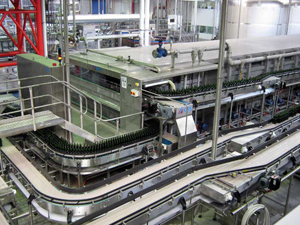
Touring Coopers Brewery

Coopers is Australia’s largest independent brewery. Still run by members of the Cooper family, they have held their own through many difficult periods for almost 150 years. Most of their beers are ales, brewed with the same care and yeast that was used over a century ago.
As the world’s largest exporter of home brew products, they have also introduced thousands to the joy of brewing it yourself.
Come with me as I go on a pilgrimage to the home of Coopers Brewery at Regency Park, South Australia.
 Mid morning on the day of the tour, I get a phone call from an unknown Adelaide number. It is Frank from Coopers Customer Service. He is calling to make sure that we know where to go and that we will be wearing the appropriate (closed-toed) footwear. Very considerate I thought, and after the call, I’m even more eager to take the tour.
Mid morning on the day of the tour, I get a phone call from an unknown Adelaide number. It is Frank from Coopers Customer Service. He is calling to make sure that we know where to go and that we will be wearing the appropriate (closed-toed) footwear. Very considerate I thought, and after the call, I’m even more eager to take the tour.
We arrive at Coopers at a quarter to one, and go through the security gate, before heading to the pavilion. The pavilion is a smaller building near South Road that serves as corporate entertainment centre and brewery museum.
At one o’clock Frank arrives, and shows us into the museum. This is a room covered with much of the history of Coopers, including old bottles, signs, and equipment. It also has a large family tree that links a number of current Cooper’s staff to the original Thomas Cooper.
After a quick browse through the museum while waiting for latecomers, we watched an introductory video that highlighted some pivotal details about Coopers history. The video went from Thomas Cooper and his first wife, to the 1977 change in Australian law that allowed home brewing, and on to 1990 when Glenn, Tim, and Melanie Cooper joined the company to help bring about the changes needed for the future. The Regency Park address was bought in 1998 to replace the small and aging Leabrook address, which had been used for over 100 years.
It was interesting that the video mentioned the ‘Champagne-style’ secondary fermentation that occurs in the bottles of Coopers ales. Perhaps this is a fitting description considering that champagne is positioned as a premium drink.
 Frank then explained his customer service position and that he would be able to answer any questions, including technical ones. What a nice change from tours that are available at other large breweries.
Frank then explained his customer service position and that he would be able to answer any questions, including technical ones. What a nice change from tours that are available at other large breweries.
An important aspect of brewing operations at any brewery today is environmental concerns. So, it is fitting that the first part of the tour includes a look at the cogeneration plant. Simply put, it is a natural gas powered turbine electrical generator. While the generator supplies the electricity, the heat is used to produce steam for use in brewing, malt evaporation, and packaging. This combination results in an energy efficiency of around 80%, which is well over the efficiency of most power stations. Excess electricity, about three quarters of it, is fed back into the electricity grid.
Similarly, Coopers use aquifer water in the brewery, to reduce the demand on the city’s potable water supply. This salty water is purified using reverse osmosis. Any wastewater, about 30%, is piped 7 km underground to the Barker Inlet Wetlands. The salt content of the wastewater is similar to that naturally occurring in these inter-tidal wetlands.
The grain silos and fermenters are next on the tour. Spent grains and trub are sold as stock feedstock. The grains are delivered via trucks to a grain elevator that takes it to the appropriate silo. They are stored in the silos, until required for brewing. The grains are weighed, and then pass through a hammer mill, on the way to the mash tun. Our tour follows the path of the grain into the brewery.
In the brewery, we are met by an abundance of stainless tanks and a mass of pipes. Following Frank upstairs, we come into a large room that is the top floor of the brewery; here we find the tops of the tanks we saw down below. There are two mash tuns, a brew kettle, and a whirlpool. The second mash tun was installed in August 2011, and will improve the brewery’s output by about 50 per cent. A Steeles Masher was installed at the same time. It mixes the grain and water as it enters the mash tun, and improves the mash efficiency.
To the side of the original mash tun is an unusual multi-segmented contraption. It is a 60-segment mash filter designed by the Belgian company, Meura. It has a number of advantages over normal sparging, including no stuck sparges, and is well suited to produce high gravity worts used in malt extract production. It is capable of producing wort with a gravity up to 25.6° Plato, which makes for better malt extracts.
The thin chambers of the filter are filled with the mash and are then squeezed to extract clear wort. Very little sparging liquor is required is required to complete the sparge. The clear wort moves on to the brew kettle. The filter chambers are then opened and the spent grains removed using an automated process.
Coopers use specialised equipment to take good care of their yeast, once again made by Meura. They have been using the same the same ale yeast that Thomas Cooper used over 100 years ago. Around 2,500 litres of ale yeast is added at 16° C to the 170,000 litre fermenters. At the end of fermentation, the yeast is removed by centrifuge. Some is washed and stored for reuse, while the remainder is sold off for stock feed. (It seems the contented cows may have a flatulence problem.)
The packaging room is next on the tour. It is quite mesmerising to watch the bottles whiz past as they are cleaned, filled, and labelled. Before bottling, the beer is primed with a measured dose of yeast and sugar. The 144-head bottle filler is capable of filling up to 1200 bottles per minute. A can filler is right next to the bottle filler. It is used for production of the (almost) mythical Dr Tim’s Pale Ale. Dr Tim’s is Coopers Pale Ale that is packaged in cans, especially for sporting events in South Australia. The canned pale ale costs more to produce than the bottled variety, due to the complexity that comes from dealing with beer that has not yet been carbonated. Like the bottles, it undergoes a secondary fermentation in the can.
The last stop on our tour was the malt extract area of the plant. They produce about 8500 tonnes of malt extract and are the largest malt producer in the southern hemisphere. The malt is produced by spraying the high gravity wort into a low-pressure area that allows the water to evaporate without the loss of most of the aromatics. This process is repeated until the required concentration is achieved.
The tour then ends, all too quickly, back at the museum pavilion. Frank hands each of us souvenir ‘I’ve Done The Coopers Tour’ glasses. He then pours us samples of all the current Coopers products. We start with the low-carb Clear and move up in flavour to 62, Lager, Mild, Dr Tim’s Pale, Sparkling, Dark, Stout, and finish with the Vintage.
It is a fitting end to the tour. One couple, that had completed a tour of the Guinness Brewery in Ireland, spoke enthusiastically about how much more they enjoyed the Coopers tour. Everyone was agreed on how we appreciated Frank’s time, knowledge, and consideration, before and during the tour.
Tours cost $22 and must be booked ahead, as they are kept in groups of eleven. Twenty dollars from this goes to the Coopers Foundation charity, while the remainder goes to the government as GST. They are conducted Tuesdays to Fridays at 1PM. To book or to find out more, go to tours.coopers.com.au or call 08 8440 1800.
*The author was not a guest of the brewery for this tour and paid his own way.
[adrotate group=”1″]



